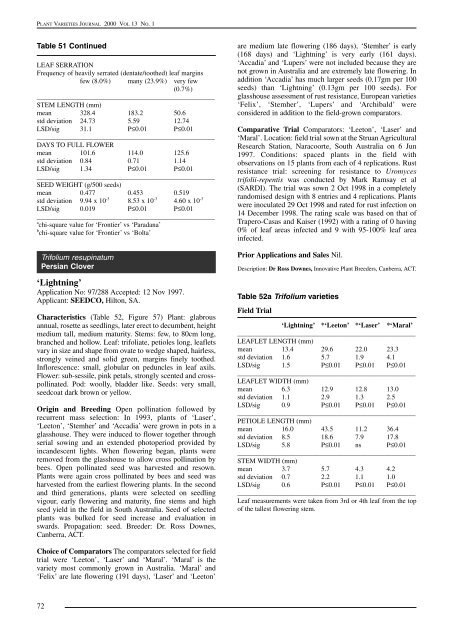53. Volume 13- Number 1 - IP Australia
53. Volume 13- Number 1 - IP Australia
53. Volume 13- Number 1 - IP Australia
You also want an ePaper? Increase the reach of your titles
YUMPU automatically turns print PDFs into web optimized ePapers that Google loves.
PLANT VARIETIES JOURNAL 2000 VOL <strong>13</strong> NO. 1<br />
Table 51 Continued<br />
LEAF SERRATION<br />
Frequency of heavily serrated (dentate/toothed) leaf margins<br />
few (8.0%) many (23.9%) very few<br />
(0.7%)<br />
____________________________________________________<br />
STEM LENGTH (mm)<br />
mean 328.4 183.2 50.6<br />
std deviation 24.73 5.59 12.74<br />
LSD/sig 31.1 P≤0.01 P≤0.01<br />
____________________________________________________<br />
DAYS TO FULL FLOWER<br />
mean 101.6 114.0 125.6<br />
std deviation 0.84 0.71 1.14<br />
LSD/sig 1.34 P≤0.01 P≤0.01<br />
____________________________________________________<br />
SEED WEIGHT (g/500 seeds)<br />
mean 0.477 0.453 0.519<br />
std deviation 9.94 x 10 -3 8.53 x 10 -3 4.60 x 10 -3<br />
LSD/sig 0.019 P≤0.01 P≤0.01<br />
____________________________________________________<br />
a chi-square value for ‘Frontier’ vs ‘Paradana’<br />
b chi-square value for ‘Frontier’ vs ‘Bolta’<br />
Trifolium resupinatum<br />
Persian Clover<br />
‘Lightning’<br />
Application No: 97/288 Accepted: 12 Nov 1997.<br />
Applicant: SEEDCO, Hilton, SA.<br />
Characteristics (Table 52, Figure 57) Plant: glabrous<br />
annual, rosette as seedlings, later erect to decumbent, height<br />
medium tall, medium maturity. Stems: few, to 80cm long,<br />
branched and hollow. Leaf: trifoliate, petioles long, leaflets<br />
vary in size and shape from ovate to wedge shaped, hairless,<br />
strongly veined and solid green, margins finely toothed.<br />
Inflorescence: small, globular on peduncles in leaf axils.<br />
Flower: sub-sessile, pink petals, strongly scented and crosspollinated.<br />
Pod: woolly, bladder like. Seeds: very small,<br />
seedcoat dark brown or yellow.<br />
Origin and Breeding Open pollination followed by<br />
recurrent mass selection: In 1993, plants of ‘Laser’,<br />
‘Leeton’, ‘Stemher’ and ‘Accadia’ were grown in pots in a<br />
glasshouse. They were induced to flower together through<br />
serial sowing and an extended photoperiod provided by<br />
incandescent lights. When flowering began, plants were<br />
removed from the glasshouse to allow cross pollination by<br />
bees. Open pollinated seed was harvested and resown.<br />
Plants were again cross pollinated by bees and seed was<br />
harvested from the earliest flowering plants. In the second<br />
and third generations, plants were selected on seedling<br />
vigour, early flowering and maturity, fine stems and high<br />
seed yield in the field in South <strong>Australia</strong>. Seed of selected<br />
plants was bulked for seed increase and evaluation in<br />
swards. Propagation: seed. Breeder: Dr. Ross Downes,<br />
Canberra, ACT.<br />
are medium late flowering (186 days), ‘Stemher’ is early<br />
(168 days) and ‘Lightning’ is very early (161 days).<br />
‘Accadia’ and ‘Lupers’ were not included because they are<br />
not grown in <strong>Australia</strong> and are extremely late flowering. In<br />
addition ‘Accadia’ has much larger seeds (0.17gm per 100<br />
seeds) than ‘Lightning’ (0.<strong>13</strong>gm per 100 seeds). For<br />
glasshouse assessment of rust resistance, European varieties<br />
‘Felix’, ‘Stemher’, ‘Lupers’ and ‘Archibald’ were<br />
considered in addition to the field-grown comparators.<br />
Comparative Trial Comparators: ‘Leeton’, ‘Laser’ and<br />
‘Maral’. Location: field trial sown at the Struan Agricultural<br />
Research Station, Naracoorte, South <strong>Australia</strong> on 6 Jun<br />
1997. Conditions: spaced plants in the field with<br />
observations on 15 plants from each of 4 replications. Rust<br />
resistance trial: screening for resistance to Uromyces<br />
trifolii-repentis was conducted by Mark Ramsay et al<br />
(SARDI). The trial was sown 2 Oct 1998 in a completely<br />
randomised design with 8 entries and 4 replications. Plants<br />
were inoculated 29 Oct 1998 and rated for rust infection on<br />
14 December 1998. The rating scale was based on that of<br />
Trapero-Casas and Kaiser (1992) with a rating of 0 having<br />
0% of leaf areas infected and 9 with 95-100% leaf area<br />
infected.<br />
Prior Applications and Sales Nil.<br />
Description: Dr Ross Downes, Innovative Plant Breeders, Canberra, ACT.<br />
Table 52a Trifolium varieties<br />
Field Trial<br />
‘Lightning’ *‘Leeton’ *‘Laser’ *‘Maral’<br />
____________________________________________________<br />
LEAFLET LENGTH (mm)<br />
mean <strong>13</strong>.4 29.6 22.0 23.3<br />
std deviation 1.6 5.7 1.9 4.1<br />
LSD/sig 1.5 P≤0.01 P≤0.01 P≤0.01<br />
____________________________________________________<br />
LEAFLET WIDTH (mm)<br />
mean 6.3 12.9 12.8 <strong>13</strong>.0<br />
std deviation 1.1 2.9 1.3 2.5<br />
LSD/sig 0.9 P≤0.01 P≤0.01 P≤0.01<br />
____________________________________________________<br />
PETIOLE LENGTH (mm)<br />
mean 16.0 43.5 11.2 36.4<br />
std deviation 8.5 18.6 7.9 17.8<br />
LSD/sig 5.8 P≤0.01 ns P≤0.01<br />
____________________________________________________<br />
STEM WIDTH (mm)<br />
mean 3.7 5.7 4.3 4.2<br />
std deviation 0.7 2.2 1.1 1.0<br />
LSD/sig 0.6 P≤0.01 P≤0.01 P≤0.01<br />
____________________________________________________<br />
Leaf measurements were taken from 3rd or 4th leaf from the top<br />
of the tallest flowering stem.<br />
Choice of Comparators The comparators selected for field<br />
trial were ‘Leeton’, ‘Laser’ and ‘Maral’. ‘Maral’ is the<br />
variety most commonly grown in <strong>Australia</strong>. ‘Maral’ and<br />
‘Felix’ are late flowering (191 days), ‘Laser’ and ‘Leeton’<br />
72

















